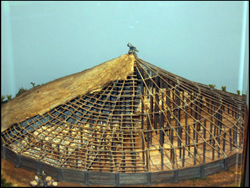 |
| As part of a reenactment at Navan Fort, this man discusses how an early-Christian settler might hunt for food. |
To the naked eye the large grassy mound, tucked into the scenery just west of Armagh, could be mistaken for one of the many rolling hills of the area. However, buried deep below the surface, far out of view, lies a history rich with human artifacts and remains dating back nearly 7,500 years. The site of Navan Fort , once known as Emain Macha (meaning "Twins of Macha"), was the ancient capital of Ulster, at once a political, spiritual, and cultural hub. The site today reflects the historical importance of the surrounding area since it is said to be the first seat of Ireland's high kings.
Navan Fort is a nearly perfectly circular enclosure measuring 250 meters in diameter surrounded by a large bank and ditch, in an unusual design. The ditch is built inside the bank, which suggests that it was not made for defensive purposes. Archaeologists believe the first settled farmers of the area may have used Navan for religious purposes.
"There appears to be a big ritual settlement associated with Celtic chieftans," says museum curator Greer Ramsey. The finds indicate aristocratic or royal occupation. One of the most interesting finds is the skull of a North African ape, which is thought to have been brought to Ireland as an exotic present for someone of royal status. "Whoever lived in the vicinity of Navan had contacts going to the Mediterranean," Ramsey says.
Research into the Navan site began around 1950 with the excavation of the lowest circular earth mound and work on the high mound continued between 1961 and 1971.
Although the findings have been somewhat minimal, there has been evidence of occupation in the area of Navan as early as the late Mesolithic period (5,500 B.C.-4,500 B.C.), as well as the Neolithic period (4,500 B.C.-2,500 B.C.), and the early Bronze Age (2,500 B.C.-1,200 B.C.). Flint tools and other various objects found at Navan suggest the presence of Ireland's earliest hunters and gatherers at the site.
Substantial activity seems to have occurred throughout the late Bronze Age (1200 B.C.-300 B.C.) in Navan and in the land just to the west. A hill fort, later named Haughey's Fort, was discovered with the use of aerial photography. Excavation of the fort yielded proof of gold working, as well as the skull of a prehistoric dog. Furthermore, a ditched enclosure, with another small circular enclosure inside it, was built at Navan in the later part of the late Bronze Age. This was the foremost site of activity in the Navan area.
The early Iron Age (300 B.C.-A.D. 400) found the first buildings constructed in this area. The first of a series of round houses was built and laid out in a figure eight design. Etchings show that this structure was rebuilt a total of nine times in the same place, until somewhere around 100 B.C.
 |
The most intriguing building in the area dates to around 95 B.C. A large oak pole was placed in the ground in the center of the circle and stretches high in the air. Nearly 300 more posts were arranged around the structure in five concentric rings. This construction, although grand, only stood for a very short time and was never inhabited. Soon after being built, the structure was filled with a great cairn of limestone and was deliberately set afire. While the reasoning for this action is uncertain, it is believed the ceremonial fire played a role in a ritual or religious ceremony to send the burned remains of the dead to the world of the gods. After the fire, the burned stones were covered by sod, concealing the bundle underground, and creating the mound that can be seen today.
In addition to the ancient buildings and artifacts, the Navan Fort is the source of many of the well-known Celtic myths associated with the Ulster Cycle. The name Emain Macha, meaning "the twins of Macha," was derived from the legend of Queen Macha and her curse of Ulster. The Navan Fort also plays a significant role in other legends including the story of Deirdre and Noisiu, Cuchullain and the king's hound, and the cattle raid of Cooley.
To the eye, Navan Fort appears to be another hill within the Irish landscape, but buried beneath the rich soil and lush vegetation lies the remains of an ancient people and their story.
Story by Cate Oliver
Photos by Roisin Kelly
Video by Charlotte Levins
Web Design by Sarah Turner
|

